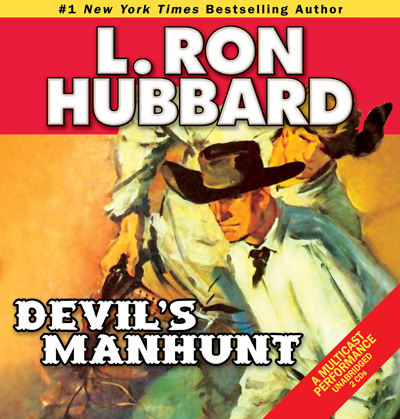Embittered by past failures and broken dreams, American fighter pilot David Duane believes in but one cause—his own. Europe is at war, and he’ll fight it for a price, selling his deadly flying skills to the highest bidder.
Duane has come to the icy white wastes of Scandinavia to wage a private war in the skies. But he’s about to take off on a flight and undertake an unforgettable journey—On Blazing Wings—to a place beyond the imagination … leading to a revelation that will open his eyes and his heart.
In a world divided by war, Duane discovers that sometimes you have to make a choice and that making the wrong one could cost him the woman he loves.
Performers: R.F. Daley (narrator), Bob Caso, Christina Huntington, John Mariano, Kelly Ward, and Phil Proctor.
“An exciting—and surprisingly moving—conclusion.” —Booklist
* International Book Award Winner
SAMPLE
ABOUT THE AUTHOR
As a barnstorming pilot in the early days of aviation, L. Ron Hubbard was dubbed “Flash” Hubbard by the aviation magazines of the day. His unique personal and pioneering knowledge of flight streaks across the page in novels like On Blazing Wings.
On Blazing Wings Glossary
Stories from the Golden Age reflect the words and expressions used in the 1930s and 1940s, adding unique flavor and authenticity to the tales. While a character’s speech may often reflect regional origins, it also can convey attitudes common in the day. So that readers can better grasp such cultural and historical terms, uncommon words or expressions of the era, the following glossary has been provided.
ack-ack: an antiaircraft gun or its fire.
aileron: a hinged flap on the trailing edge of an aircraft wing, used to control banking movements.
altimeter: a gauge that measures altitude.
ASI: airspeed indicator.
bandolier: a broad belt worn over the shoulder by soldiers and having a number of small loops or pockets for holding cartridges.
beam: an early form of radio navigation using beacons to define navigational airways. A pilot flew for 100 miles guided by the beacon behind him and then tuned in the beacon ahead for the next 100 miles. The beacons transmitted two Morse code signals, the letter “A” and the letter “N.” When the aircraft was centered on the airway, these two signals merged into a steady, monotonous tone. If the aircraft drifted off course to one side, the Morse code for the letter “A” could be faintly heard. Straying to the opposite side produced the “N” Morse code signal. Used figuratively.
choom: (Lapp) a tent made of skins or bark.
cordite: a family of smokeless propellants, developed and produced in the United Kingdom from the late nineteenth century to replace gunpowder as a military propellant for large weapons, such as tank guns, artillery and naval guns. Cordite is now obsolete and no longer produced.
cowl: a removable metal covering for an engine, especially an aircraft engine.
Democratic People’s Government of Finland (DPGF): also known as the Terijoki Government; a Soviet puppet regime created in the occupied Finnish border town of Terijoki on December 1, 1939. It was used for both diplomatic and military purposes. They hoped it would encourage Socialists in Finland’s army to defect.
drome: short for airdrome; a military air base.
flimsy: thin paper usually used to make multiple copies.
Fokker D.XXI: a fighter plane designed in 1935 and used by the Finnish Air Force in the early years of World War II. Designed as a cheap and small but rugged plane, they were very suitable for the Finnish winter conditions. They performed better and for much longer than other fighter planes acquired prior to the start of the war, and were more evenly matched with the fighter planes of the Soviet Air Force.
Galahad: Sir Galahad; the noblest knight of the Round Table, who succeeded in his quest for the Holy Grail (cup or plate that possessed miraculous powers; according to medieval legend it was used by Jesus at the Last Supper and later became sought by medieval knights). Upon this achievement, he was taken up into heaven, leaving behind two companions and fellow knights who also sought the Holy Grail.
G-men: government men; agents of the Federal Bureau of Investigation.
hearse plume: on antique horse-drawn hearses, a feather plume, usually ostrich feathers dyed black, used to decorate the tops of the horses’ heads.
I-15: Soviet fighter biplane.
Ilmavoimat, Lentorykmentti: (Finnish) a flying regiment in the air force.
inertia starter: a device for starting engines. During the energizing of the starter, all movable parts within it are set in motion. After the starter has been fully energized, it is engaged to the crankshaft of the engine and the flywheel energy is transferred to the engine.
Kalgan: a city in northeast China near the Great Wall that served as both a commercial and a military center. Kalgan means “gate in a barrier” or “frontier” in Mongolian. It is the eastern entry into China from Inner Mongolia.
Lapland: a region of extreme northern Europe including northern Norway, Sweden and Finland and the Kola Peninsula of northwest Russia. It is largely within the Arctic Circle.
Lufbery circle: an air combat tactic that was most commonly used during World War I. It was purely defensive in nature and involved all members of the defending aircraft forming a horizontal circle in the air when attacked, with each plane theoretically protecting the plane in front of him. This tactic was intended for slower, less capable aircraft when attacked by aggressive enemy fighters, and with bombers it had the added benefit of defensive gunners that further prevented enemy fighters from attacking the formation.
M-17: a Soviet-licensed copy of a German BMW aircraft engine used in the early versions of the TB-3 heavy bomber.
mags: magnetos; small ignition system devices that use permanent magnets to generate a spark in internal combustion engines, especially in marine and aircraft engines.
Mannerheim Line: a defensive fortification on the Karelian Isthmus (a land bridge between Russia and Finland) built by Finland against the Soviet Union. During the Winter War (1939–1940) it became known as the Mannerheim Line, after Field Marshal C. G. E. Mannerheim who designed the plans for it. Some of the most fierce fighting of the Winter War took place along this line.
Mercury VII: type of engine in the Fokker D.XXI plane.
militzka: (Samoyed, the language of the nomadic peoples of northern Siberia) winter coat made of reindeer hide.
monoplane: an airplane with one sustaining surface or one set of wings.
motor cannon: a type of gun that shoots through the propeller hub of a fighter plane.
mufti: civilian clothes; ordinary clothes worn by somebody who usually wears a uniform.
mujiks: (Russian) peasants.
Murmansk: a city of northwest Russia on an inlet of the Barents Sea. A major ice-free port, it was an important supply line to Russia in World Wars I and II.
noita: (Finnish) a shaman who by means of falling into a trance travels to the spirit world to meet the souls of the dead who can offer wisdom otherwise unattainable.
Odessa: a seaport in southern Ukraine on the Black Sea.
otriad: (Russian) detachment; a military unit separated from its normal, larger unit for special duties.
parole: word of honor, especially that of a prisoner of war who is granted freedom only after promising not to engage in combat.
Percivale, Sir: a knight of the Round Table who sought the Holy Grail (cup or plate that possessed miraculous powers; according to medieval legend it was used by Jesus at the Last Supper and later became sought by medieval knights).
pimmies: (Samoyed, the language of the nomadic peoples of northern Siberia) boots made of deerskin.
Pole Star: North Star; a star that is vertical, or nearly so, to the North Pole. Because it always indicates due north for an observer anywhere on Earth, it is important for navigation.
Popular Front: a political coalition of leftist parties against fascism; in 1936 the Popular Front was formed in Spain consisting of the Communist Party of Spain, Socialists and other left-wing organizations.
Puhjola: borrowed from Pohjola in Finnish mythology, it means “the home of the north” though the term is quite vague and without geographical significance. It is considered to be the land of heroes.
Rif: Er Rif; a hilly region along the coast of northern Morocco. The Berber people of the area remained fiercely independent until they were subdued by French and Spanish forces (1925–1926).
rudder: a device used to steer ships or aircraft. A rudder is a flat plane or sheet of material attached with hinges to the craft’s stern or tail. In typical aircraft, pedals operate rudders via mechanical linkages.
samovar: a large and often ornate Russian tea urn, originally heated by a built-in charcoal burner.
Scheherazade: the female narrator of The Arabian Nights, who during one thousand and one adventurous nights saved her life by entertaining her husband, the king, with stories.
tab-trimming: adjusting the tab, a small, adjustable hinged surface, located on the trailing edge of the aileron, rudder or elevator control surface. It is adjusted by the pilot to maintain balance and to help stabilize the aircraft in flight.
tach: tachometer; a device used to determine speed of rotation, typically of an engine’s crankshaft, usually measured in revolutions per minute.
TB-3 (ANT-6): (civilian designation ANT-6) a heavy bomber aircraft that was deployed by the Soviet Air Force in the 1930s. It saw combat as a Zveno project fighter mothership and as a light tank transport.
Terijoki: a town won from Finland in a treaty with Moscow (1940) and under the jurisdiction of St. Petersburg, Russia; located on the Karelian Isthmus (land bridge connecting Finland and Russia). The town became known to the world during the Winter War as the site of the Communist puppet regime, also known as the Democratic People’s Republic of Finland. The Winter War (November 1939 to March 1940) broke out when the Soviet Union attacked Finland.
tracer: a bullet or shell whose course is made visible by a trail of flames or smoke, used to assist in aiming.
Valhalla: (Norse mythology) the great hall where the souls of heroes killed in battle spend eternity.
whipstall: a maneuver in a small aircraft in which it goes into a vertical climb, pauses briefly, and then drops toward the earth, nose first.
White Russian: a Russian who fought against the Bolsheviks (Russian Communist Party) in the Russian Revolution, and fought against the Red Army during the Russian Civil War from 1918 to 1921.
Wind Mother: (Latvian mythology) Goddess of the Wind. Latvians called all their gods “father” and all their goddesses “mother.” They pictured all their deities as parents. Latvia is a country in northern Europe along the shores of the Baltic Sea.
Wright Cyclone engine: designed in the US by the Wright Aeronautical Corporation, formed in 1919, the Cyclone was a new high-powered, air-cooled engine used extensively by the US government through World War II.
zero-zero: (of atmospheric conditions) having or characterized by zero visibility in both horizontal and vertical directions. Used figuratively.
Zveno: Zveno project; a parasite aircraft project developed in the Soviet Union during the 1930s. It consisted of a TB-3 heavy bomber acting as a mothership for between two and five fighters. The fighters either launched with the mothership or docked in flight and they could refuel from the bomber.











